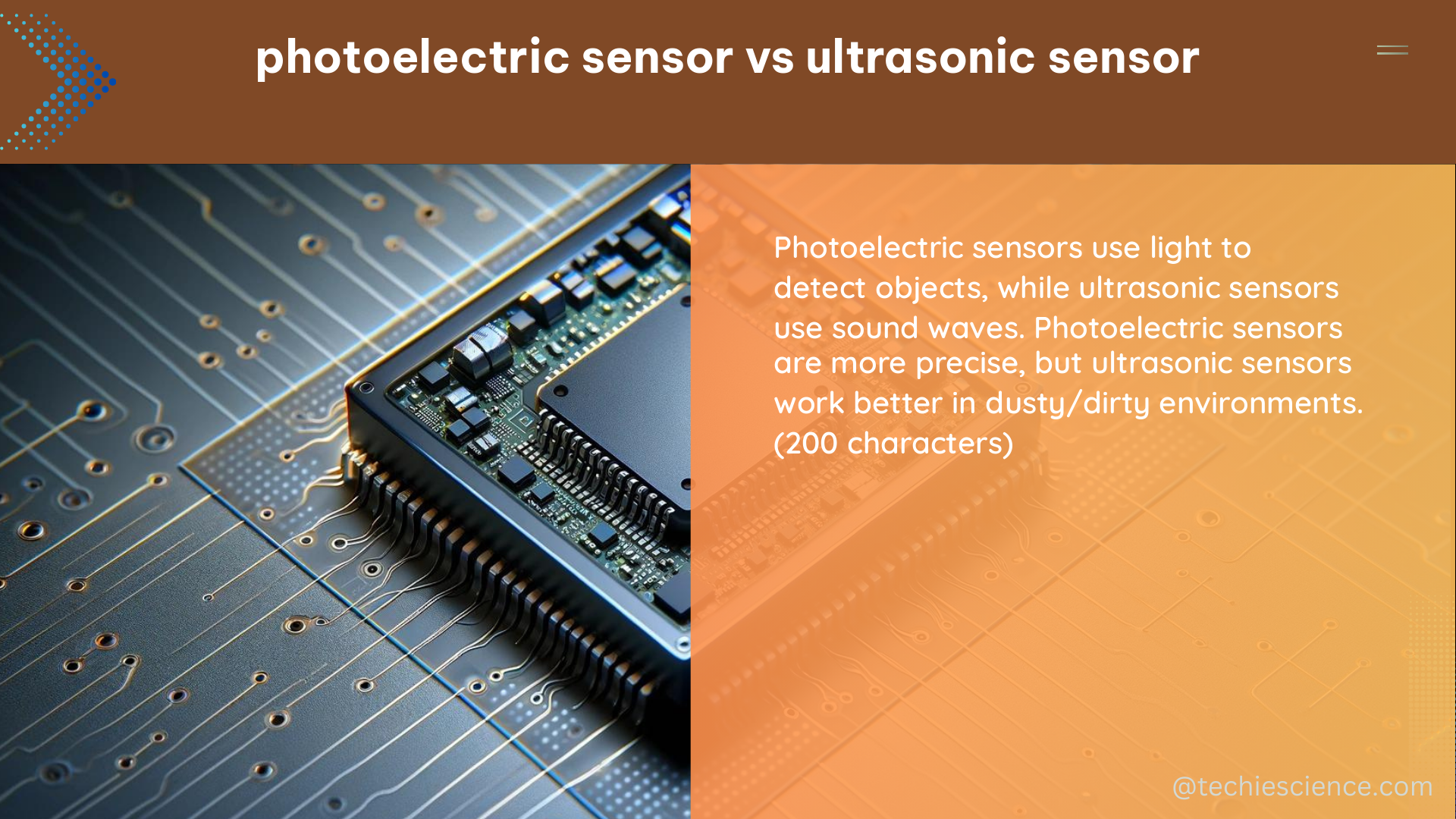Photoelectric sensors and ultrasonic sensors are two widely used technologies in industrial automation, robotics, and various other applications for distance measurement and object detection. Understanding the key differences between these two sensor types is crucial for selecting the right solution for your specific needs. In this comprehensive blog post, we’ll dive deep into the technical specifications, performance characteristics, and practical considerations of photoelectric sensors and ultrasonic sensors.
Detection Range and Accuracy
Photoelectric Sensors:
– Typical detection range: Up to a few meters, with a maximum range of around 70 meters when used with a reflector.
– Accuracy: Photoelectric sensors generally have high accuracy, with typical repeatability of ±0.1 mm to ±1 mm, depending on the model and application.
Ultrasonic Sensors:
– Typical detection range: Up to a few meters, with a maximum range of around 8 meters.
– Accuracy: Ultrasonic sensors have lower accuracy compared to photoelectric sensors, with typical repeatability of ±1 mm to ±5 mm.
The longer detection range and higher accuracy of photoelectric sensors make them suitable for applications that require precise distance measurement, such as position control, part counting, and web tension monitoring. Ultrasonic sensors, on the other hand, excel in applications where the target object’s color, transparency, or surface texture may affect the performance of photoelectric sensors.
Response Time and Environmental Factors

Response Time:
– Photoelectric sensors have a faster response time, typically in the range of 0.1 ms to 10 ms, making them suitable for high-speed applications.
– Ultrasonic sensors have a slower response time, typically in the range of 20 ms to 200 ms, which may limit their use in applications that require rapid object detection and response.
Environmental Factors:
– Photoelectric sensors are susceptible to interference from ambient light, such as sunlight or artificial lighting, which can affect their performance.
– Ultrasonic sensors are less affected by environmental factors like lighting conditions, making them more suitable for applications in harsh or variable environments.
Ultrasonic sensors can also detect transparent objects, black objects, and many liquids, which can be challenging for photoelectric sensors. However, ultrasonic sensors may struggle with sound-absorbent materials, while photoelectric sensors can reliably sense these types of objects.
Installation and Setup Considerations
Photoelectric Sensors:
– Photoelectric sensors have a small, bright laser spot, making them ideal for detecting small objects or objects at high angles of incidence.
– They often require additional setup, such as alignment and adjustment, to ensure optimal performance.
Ultrasonic Sensors:
– Ultrasonic sensors have a 3-dimensional detection zone shaped like a cone, making them well-suited for zone detection applications.
– Many ultrasonic sensors come with built-in push buttons or accessories, simplifying the installation and configuration process.
The choice between photoelectric and ultrasonic sensors will depend on the specific requirements of your application, such as the size and shape of the target objects, the environmental conditions, and the desired level of precision and response time.
Technical Specifications and Principles of Operation
Photoelectric Sensors:
– Photoelectric sensors use a light beam, typically infrared or visible light, to detect the presence of an object.
– They can employ various detection methods, such as diffuse, retroreflective, or through-beam, depending on the application requirements.
Ultrasonic Sensors:
– Ultrasonic sensors use sound waves to detect the presence and distance of objects.
– They operate based on the Time of Flight (ToF) principle, measuring the time it takes for the sound wave to travel from the sensor to the object and back.
The different operating principles of photoelectric and ultrasonic sensors result in their unique strengths and limitations, making them suitable for different types of applications.
Practical Applications and Use Cases
Photoelectric sensors are commonly used in the following applications:
– Precise position control and part counting
– Web tension monitoring
– Packaging and labeling
– Conveyor belt monitoring
– Robotics and automation
Ultrasonic sensors are often used in:
– Level measurement and tank monitoring
– Collision avoidance and proximity detection
– Liquid and material handling
– Parking and access control systems
– Robotics and automation
The choice between photoelectric and ultrasonic sensors will depend on the specific requirements of your application, such as the target object’s properties, the environmental conditions, and the desired level of precision and response time.
Conclusion
Photoelectric sensors and ultrasonic sensors are both valuable tools in the world of industrial automation and robotics, each with its own unique strengths and applications. By understanding the key differences in detection range, accuracy, response time, environmental factors, and technical specifications, you can make an informed decision on the best sensor technology for your specific needs. This comprehensive guide has provided you with the necessary information to navigate the world of photoelectric and ultrasonic sensors and select the right solution for your project.
References:
– DigiKey, “Product Detection and Ranging Using Ultrasonic Sensors,” 2022-01-18, https://www.digikey.com/en/articles/product-detection-and-ranging-using-ultrasonic-sensors
– Balluff, “Choosing the right sensor for measuring distance,” 2022, https://www.balluff.com/en-us/blog/choosing-the-right-sensor-for-measuring-distance
– Ray Ferrier, “Understanding the differences between Ultrasonic and Photoelectric technologies,” LinkedIn, 2018-09-03, https://www.linkedin.com/pulse/understanding-differences-between-ultrasonic-ray-ferrier
– DesignSpark, “Understanding the differences between Ultrasonic and Photoelectric technologies,” 2017-09-11, https://www.rs-online.com/designspark/understanding-the-differences-between-ultrasonic-and-photoelectric-technologies
– Keyence, “Comparison between Ultrasonic Sensors and Optical Sensors,” n.d., https://www.keyence.com/ss/products/sensor/sensorbasics/ultrasonic/comparison/

The lambdageeks.com Core SME Team is a group of experienced subject matter experts from diverse scientific and technical fields including Physics, Chemistry, Technology,Electronics & Electrical Engineering, Automotive, Mechanical Engineering. Our team collaborates to create high-quality, well-researched articles on a wide range of science and technology topics for the lambdageeks.com website.
All Our Senior SME are having more than 7 Years of experience in the respective fields . They are either Working Industry Professionals or assocaited With different Universities. Refer Our Authors Page to get to know About our Core SMEs.